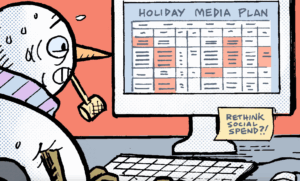 James Deaker recently joined Yahoo! as VP Data Solutions and Insights after leaving his position at Microsoft as Director, Monetization Excellence. He discussed his new role and publisher strategy with AdExchanger.com.
James Deaker recently joined Yahoo! as VP Data Solutions and Insights after leaving his position at Microsoft as Director, Monetization Excellence. He discussed his new role and publisher strategy with AdExchanger.com.
AdExchanger.com: Tell me about your new role and why it’s a good fit for you.
JD: I’m joining Yahoo! because I’m amazed by Yahoo!’s leadership position in the digital medium. My focus is to ensure Yahoo!’s products and insights for advertisers and marketers differentiate us in the industry.
Specifically, I will be leading a new organization responsible for data solutions, custom analytics, and data quality. Yahoo! has one of the largest business and data analyst communities of any major publisher on the Web, and we know that sharing techniques and best practices within this community is crucial to delivering unique perspectives to advertisers and publishers.
The reason the role is exciting to me is that we all know the web experience generates petabytes of data, but so often we all get stuck in the noise associated with the technology and the vast quantities of data. It is easy to focus on the technologies, like RTB, that are delivered by the Exchanges, DSPs, SSPs, etc. However, we need to pause and think about how we are delivering insights that make life better for the content consumers and advertisers who want to engage with those consumers. Yahoo! understands this and is making significant investments in these areas.
In your opinion, where do publishers make mistakes today in terms of monetization and yield management?
Wow, that’s a big question because there are so many! To be clear, while my focus over the last few years at Rapt and then at Microsoft was on pricing and yield questions, my new role at Yahoo has a broader and different charter than simply Publisher Monetization. That said, there are three key mistakes I’ve seen repeated.
Publishers forget about the customer: the advertiser. What are the attributes the advertiser values and for which a premium price can be charged? This is easy for Direct Response marketers: clicks, actions, engagement, and transactions. But for most Brand Advertisers the metrics are more nuanced, and the people who understand this are the Account Executives and Account Managers, who are often organizationally separated from the Yield Management and Monetization teams.
Publishers over-complicate pricing. Publishers want to generate a unique price for each product or page-group on their rate card because they have been sold on the promise of yield-management similar to the airline industry. For a major publisher this can literally result in thousands of products. While self-serve automated platforms might one day make this a reality, for the time being most of the transactions are still done through negotiations between advertisers and publisher sales teams and in practice sales teams need a simple rate card that they can sell off. In the past I’ve used the analogy of a publisher rate card being like a restaurant menu. You need to be able to both justify the prices, but also defend the products that are on it… and fit it on one page! Just because the technology exists to price every page-group code doesn’t mean you should be using it.
Publishers fail to enforce pricing. Most publishers do a terrible job managing discounts and will trash their own rate card for a big advertiser. If you believe in your rate card, and you believe that it is aligned with market prices, then you should hold the line on your most valuable products. If you can’t then your products really are a commodity, or your sales force doesn’t know how to sell value.
From your point of view, where does a seller begin when setting pricing and creating a rate card?
The publisher must begin with two factors: what matters to the advertiser and what differentiates the site from other properties. In the end nothing else matters. Most publishers don’t stop to think about why they are differentiated from their competitors. Is it the contextual experience? The user profile? The specificity of the content? The technological ability to target? If the publisher doesn’t know or can’t answer these questions, they may want to consider letting the market decide the value of their inventory based on how it performs for direct response. Then, the publisher can learn from that experience by careful observation of the pricing dynamics. To command premium pricing, publishers must present their inventory to brand advertisers for whom the audience and context matter.
What is surprising you these days about digital advertising?
I’m still surprised by the immaturity of our industry and the persistent fragmentation. The good news is this drives continuing innovation. The bad news is we still lack the level of standardization required for major advertisers to allocate their budgets more efficiently and broadly across the media.
What will be your own success metrics at Yahoo!? -as in, what do you hope to accomplish?
Yahoo! is aggressively executing on its product strategy under Blake Irving’s leadership. Blake and Carol both have set the tone and demonstrated a commitment to the importance of data and analytics in driving business results. My personal commitment is to support this evolution by creating insights and data solutions that enable us to deliver ad products to advertisers and content and communications experiences to users in a unique way. I am very excited to have the opportunity to a make a difference at Yahoo!’s scale and positively impact the lives of over 600 million consumers globally.
By John Ebbert













